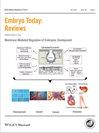下载PDF
{"title":"Incidence, pathophysiology, and clinical manifestations of antiphospholipid syndrome","authors":"Clifton O'neill Brock, Andrew Scott Brohl, Sarah Gloria Običan","doi":"10.1002/bdrc.21107","DOIUrl":null,"url":null,"abstract":"<p>Antiphospholipid syndrome (APLS) is a complex systemic disease with a wide variety of clinical manifestations. In the obstetric population, recurrent early pregnancy loss, fetal loss, and thrombosis are hallmarks of the disease. Patients with APLS have developed one or more pathogenic auto-antibodies directed against plasma and cell surface proteins. These antibodies are characterized by their affinity for anionic phospholipids. Interactions between APLS antibodies and their protein targets influence a wide variety of biological systems and signaling pathways, including monocytes, platelets, the complement system, and endothelial cells. While much research is currently directed at understanding the mechanisms involved in this autoimmune disease, the key clinical presentation is the hypercoagulable state resulting in thrombosis occurring in essentially any arterial or venous location, as well as numerous obstetrical complications. Treatment of APLS is generally directed at preventing thrombosis and poor pregnancy outcomes by ameliorating the hypercoagulable state. Birth Defects Research (Part C) 105:201–208, 2015. © 2015 Wiley Periodicals, Inc.</p>","PeriodicalId":55352,"journal":{"name":"Birth Defects Research Part C-Embryo Today-Reviews","volume":"105 3","pages":"201-208"},"PeriodicalIF":0.0000,"publicationDate":"2015-09-23","publicationTypes":"Journal Article","fieldsOfStudy":null,"isOpenAccess":false,"openAccessPdf":"https://sci-hub-pdf.com/10.1002/bdrc.21107","citationCount":"13","resultStr":null,"platform":"Semanticscholar","paperid":null,"PeriodicalName":"Birth Defects Research Part C-Embryo Today-Reviews","FirstCategoryId":"1085","ListUrlMain":"https://onlinelibrary.wiley.com/doi/10.1002/bdrc.21107","RegionNum":0,"RegionCategory":null,"ArticlePicture":[],"TitleCN":null,"AbstractTextCN":null,"PMCID":null,"EPubDate":"","PubModel":"","JCR":"Q","JCRName":"Medicine","Score":null,"Total":0}
引用次数: 13
引用
批量引用
Abstract
Antiphospholipid syndrome (APLS) is a complex systemic disease with a wide variety of clinical manifestations. In the obstetric population, recurrent early pregnancy loss, fetal loss, and thrombosis are hallmarks of the disease. Patients with APLS have developed one or more pathogenic auto-antibodies directed against plasma and cell surface proteins. These antibodies are characterized by their affinity for anionic phospholipids. Interactions between APLS antibodies and their protein targets influence a wide variety of biological systems and signaling pathways, including monocytes, platelets, the complement system, and endothelial cells. While much research is currently directed at understanding the mechanisms involved in this autoimmune disease, the key clinical presentation is the hypercoagulable state resulting in thrombosis occurring in essentially any arterial or venous location, as well as numerous obstetrical complications. Treatment of APLS is generally directed at preventing thrombosis and poor pregnancy outcomes by ameliorating the hypercoagulable state. Birth Defects Research (Part C) 105:201–208, 2015. © 2015 Wiley Periodicals, Inc.
抗磷脂综合征的发病率、病理生理和临床表现
抗磷脂综合征(apl)是一种复杂的全身性疾病,具有多种临床表现。在产科人群中,复发性早期妊娠丢失、胎儿丢失和血栓形成是该病的标志。apl患者产生了一种或多种针对血浆和细胞表面蛋白的致病性自身抗体。这些抗体的特点是它们对阴离子磷脂的亲和力。apl抗体与其蛋白靶点之间的相互作用影响多种生物系统和信号通路,包括单核细胞、血小板、补体系统和内皮细胞。虽然目前许多研究都是为了了解这种自身免疫性疾病的机制,但主要的临床表现是高凝状态导致血栓形成,基本上发生在任何动脉或静脉位置,以及许多产科并发症。apl的治疗通常是通过改善高凝状态来预防血栓形成和不良妊娠结局。出生缺陷研究(C辑)(05):201 - 208,2015。©2015 Wiley期刊公司
本文章由计算机程序翻译,如有差异,请以英文原文为准。

 求助内容:
求助内容: 应助结果提醒方式:
应助结果提醒方式:


